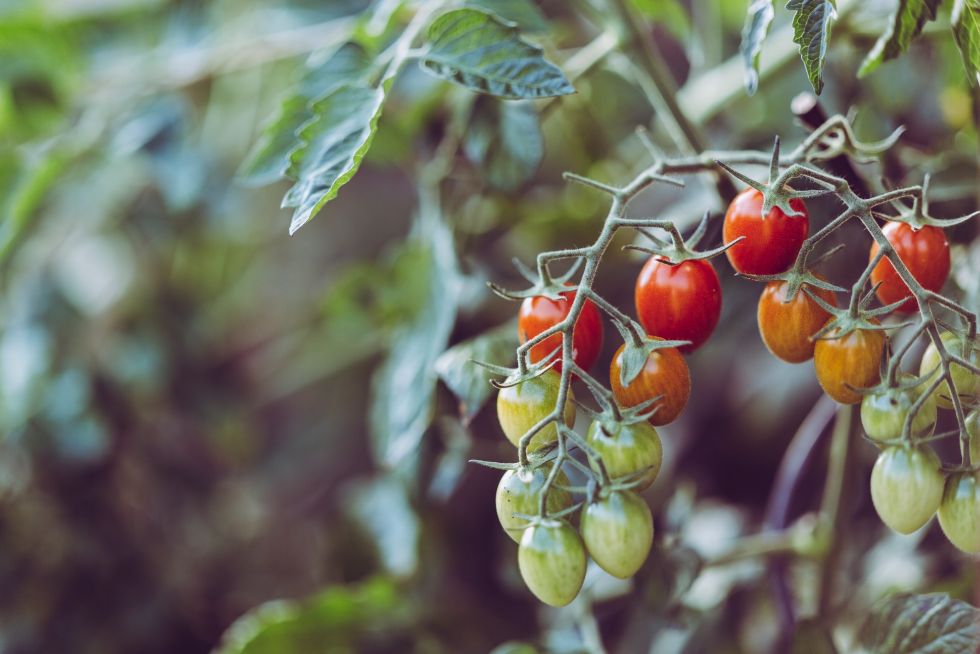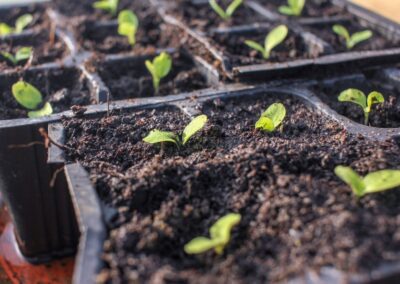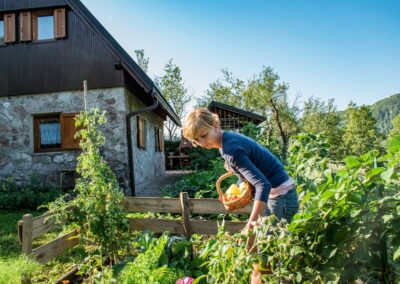Who doesn’t love a beautiful ripe delicious summer tomato? Or a homemade stewed sauce made from your garden tomatoes. There’s absolutely no comparison with the industrial store-bought tomatoes. Whether you grow a few plants on your balcony or patio, or you fill your garden with tomatoes, you’ll appreciate the effort when you see these beauties ripening on your vines. And it’s even more rewarding when you’ve been able to grow your healthy tasty tomatoes from seed!
Finding Suitable Tomato Seeds
Sourcing organic heirloom seeds (maybe even for a local tomato type) will undoubtedly give you the best results – tomato plants that are adapted to your local climate, yielding the type of tomatoes you signed up for. From then on, you can save your own seeds. I always tell people, it’s not at all hard—you just have to know how to do it!
That being said, it’s not always possible to grow tomatoes from organic seeds: you might be using soil that has been treated with herbicides, or you might be using pesticides those heirloom breeds are just not resistant to. One summer, we lost all of our tomato plants a couple of days after the neighbor had been spraying his olive trees, just one terrace uphill from where our veggie garden was back then…
Be aware, however, that if you buy F1 (hybrid) tomato seeds, you won’t be able to save the seeds. Well, you could. But they won’t grow into the same type of tomatoes they came from. To save your seed (so easy, wait and see), you need true-to-form, open-pollinated seeds.
You’ll be happy to know that tomato seeds are one of the easiest to collect from the fruit. Most of them are self-pollinating and won’t cross. Most tomatoes have small cone-shaped flowers, called anthers, (that make the pollen) that are so tight that insects can’t get in there. Additionally (as if they need more protection from insects), the receptive surface for receiving pollen, called the stigma, is very short and deep inside the cone.
Without much fuss, you’ll have a huge amount of seeds for next year. Once your fruit ripens completely on the vine, pick a few of your best tomatoes, slice them in half and you’ll see tons of seeds. Get some small glass jars, and squeeze the sliced tomato, almost like you’d squeeze a lemon, into the jar where you’ll collect both the seeds and the juice.
Preparing your Tomato Seeds
Add a bit of water and stir well, and then place those jars in a relatively warm place (no cover needed) and let the seeds ferment. You’ll notice that the “good” seeds will sink to the bottom and the “bad” seeds will float (just like “bad” eggs — nice to remember the “bad” ones both float). The reason for this three-day fermentation process is to both kill off any diseases and discard the jelly-like coating on each seed.
You’ll need to stir the seeds twice daily, and you’ll probably notice a coating of not-so-great-smelling mold on the surface of the water. After three days, spoon out the top layer of mold and then pour the seeds into a sieve and give them a good cool-water rinse. Then gently scrape the seeds out onto a porcelain or glass plate to dry (they won’t stick to these items). I sometimes scrape mine onto newspaper, then spread them out and when they’re dry, I just tear off the newspaper and plant the seed and newspaper together.
Before planting, be sure to dry the seeds somewhere without direct sunlight, but warm, not hot. You don’t want to cook them!
When completely dry, store the tomato seeds in a spice jar or some such in a cool, dry place (with or without newspaper), and they should last up to four years.
Different Types of Tomatoes
When you’re growing your own tomatoes from seed, you need to consider what you’re growing them for. Is it for snacking, eating or making salsa? Do you want to eat or process them right after harvest, or do you want to eat your home-grown tomatoes all through winter?
There are tons and tons of tomato varieties, as you might imagine.
- You have tiny sweet cherry tomatoes
- Huge green beefsteak ones
- Roma tomatoes with less juice for canning
- Hanging tomatoes that will last you through the winter
- And hundreds of obscure varieties from all over the world.
Mainly, however, there are bush tomatoes and vine tomatoes.
Bush Tomatoes vs. Vine Tomato Plants
The bush varieties grow up to four feet high, don’t need “pinching out,” might need to be caged rather than staked, and most varieties produce fruit quite quickly (and thus don’t last that long).
Tomato plants of the vine variety, on the other hand, are long and lanky and grow up to eight feet high, must be “pinched out” (or the side shoots suck up all the main stem’s energy, resulting in smaller tomatoes), need to be staked or strung up, and take longer to flower and thus produce, causing the plant to live longer than a bush variety.
You can find all about the difference between bush and vine tomatoes plus all the information about caging (for bush tomatoes) and staking (for vine tomato plants) in this article.
To learn more about “pinching out,” have a look here.
Growing Tomatoes – from Seed to Tomato
Start Tomatoes from Seed: Inside or Outdoors
Depending on where you live, you want to get your tomato seeds in the soil no later than late March or early April. If you’re growing indoors, then you have a much wider window for planting.
To grow, tomatoes need sunshine and warmth, so if you grow indoors, choose a warm sunny spot by a window. You can also start your seeds in a greenhouse or on your kitchen counter.
Planting your Tomato Seedlings Outside
When the last frost has passed and the daytime temperatures hover around 60 degrees Fahrenheit (about 15 degrees Celsius), you can plant out your tomato seedlings.
Find a nice and sunny spot to grow your tomatoes; the more sun the tomatoes get, the sweeter and tastier they will be.
Dig your holes and water them, then bury your seedling, and you’re good to go.
You don’t need much space for your tomatoes. Space them with at least about 24 inches (61 centimeters) between them and with a depth of no less than eight inches (20 centimeters) — that’s about five gallons, if you’re planting in a container. Tomatoes grow between two to three feet wide, and you want that extra space for delicious home-grown tomatoes.
So as you can see, you can grow tomatoes in containers or pots on your terrace. If you’ve got a square foot garden, you can place one tomato plant in each grid.
Tomato plant maintenance and fertilizing
Tomatoes need lots of nutrients with soil rich in potassium and phosphorus to encourage flowering and healthy tomatoes. If you can get hold of composted horse manure, all the better, as this natural fertilizer will enhance soil composition.
Tomato plants also need calcium to grow (and to avoid nasty conditions like bottom-end rot). If you eat eggs, that’s easy to fix – you can add some eggshells to the soil as you plant your seedlings, and sow some crushed eggshells on your tomato garden bed as the tomatoes are growing.
How long does it take to grow tomatoes from seed?
Tomato seeds will germinate within about 5 to 10 days in optimal conditions. Then from transplant seedling to ripe tomato, it’ll take anywhere from 50-80 days, depending on the tomato variety and your climate zone.
I’ve heard of great results with hydroponics, but I haven’t yet tried it myself. Here’s a great resource to get you started on growing tomatoes with the help of hydroponics.
Healthy Sweet Tomatoes: What’s the Secret?
Well, there is no real secret to growing great tomatoes from seed.
Tomatoes, like most plants, need adequate water, sunshine, care and healthy soil.
- Get hold of good quality organic heirloom seeds
- Plant your seedlings in a nice sunny place
- Pluck off the eventual suckers
- Keep the tomatoes watered
- Add compost around the plants (without touching the plant itself)
- And the rest is up to Mother Nature.
What To Do With All Those Tomatoes
Now that you have grown tons of tomatoes from seed — too many to eat — you can throw them into a pot and make up a delicious sauce to get you through to next year’s harvest. It’s better, however, to plan in advance, as sauces do much better with the less juicy Roma variety tomatoes. I like to stew my Romas with garlic, olive oil and salt. I slow cook them for a couple of hours until the sauce has reduced some, and then can them.
There are a variety of different canning techniques, so have a look around the Internet and find what suits you best. I personally like the Mother Earth News website most for this.
Most of all, have fun and enjoy your beautiful tomatoes. Leave your thoughts or tips in the comments below.








0 Comments